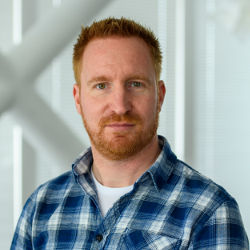About Mark van Lent

I am a software engineer at heart, with an interest in (cloud) intrastructure and a tiny homelab to scratch that itch.
How I got started
When I was young, my parents had several home computers (starting with a ZX Spectrum and later an MSX.) Although I liked playing games on them, my love for computers really started when we got a personal computer: an i386 computer with a whopping megabyte of memory running MS-DOS. I started programming on this machine (QBasic) and had fun optimizing the memory usage with e.g. QEMM. Later on, during high school, I taught myself how to write code in Pascal.
During my Computer Science study at the Delft University of Technology, I used a number of programming languages like Assembler (for the PDP-11) and Modula-2, but also the more commonly used languages like C and Java. Part-time jobs and hobby lead me to code in ColdFusion, Perl, PHP and LaTeX.
While writing my master’s thesis in 2004 someone gave me a book about Python with the words “you might also like this language.” And I did! After solving a couple of Python Challenge riddles and writing scripts to automate some tasks, I decided to make writing Python code my day job.
Will code for food
That’s how in January 2007 I ended up with Zest Software where I got introduced to the world of Zope and Plone (both written in Python). I worked on a number of projects for clients, mostly writing backend code. Since 2009 I also worked on several project where we used Django (another web framework written in Python).
In February 2011 I switched to a different company (Edition1) but my work more or less remained the same: building web applications for customers on a project basis. For most sites we used a content management system based on Plone, but there were also some Django projects.
In 2013 I left the world of Plone behind me when I got a job at Fox-IT as a Django developer. I started building a portal for the customers of their managed SOC service. This portal grew in functionality and became the tool used by the SOC analysts to investigate incidents as part of the security service we offer to our customers.
Infrastructure and ops
The development team grew and the need for more infrastructure and automation grew with it. I think it was about 2018 when I was effectively no longer a developer on the product, but I was working on the infrastructure we needed. This lead me to experiments with AWS and working with tools like Ansible, Terraform and Packer to get the job done.
As of January 2023 I joined Schuberg Philis as a Mission Critical Engineer. This meant handling the operations side of the cloud infrastructure of the client my team was responsible for. So a typical day could start with writing Terraform code to manage some AWS service to modernize the stack and the next moment we were focussed on investigating an operational problem.
Go, go, go
A bit over a year later, I switched back to a role with a focus on software engineering again—I missed writing software too much. So as of May 2024 I am still working for Schuberg Philis but now as a Mission Critical Software Engineer. And in my new team we are using Go to write our services in. So after using Python for a long time, I am now writing in Go for a living.